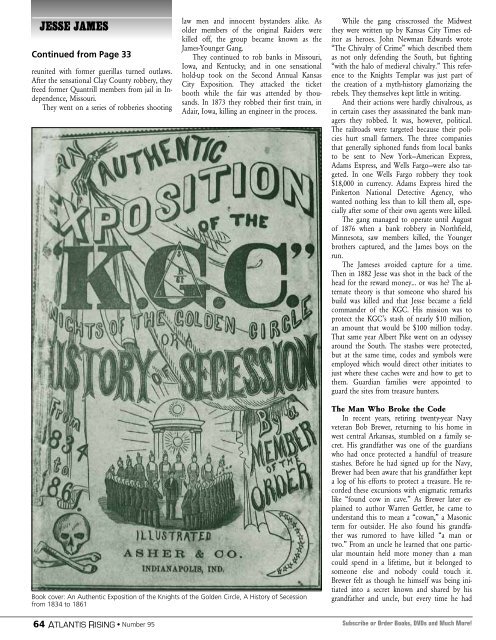Do We Know What We Think We Know About ... - TheUFOStore.com
Do We Know What We Think We Know About ... - TheUFOStore.com
Do We Know What We Think We Know About ... - TheUFOStore.com
You also want an ePaper? Increase the reach of your titles
YUMPU automatically turns print PDFs into web optimized ePapers that Google loves.
JESSE JAMES<br />
Continued from Page 33<br />
reunited with former guerillas turned outlaws.<br />
After the sensational Clay County robbery, they<br />
freed former Quantrill members from jail in Independence,<br />
Missouri.<br />
They went on a series of robberies shooting<br />
64 ATLANTIS RISING • Number 95<br />
law men and innocent bystanders alike. As<br />
older members of the original Raiders were<br />
killed off, the group became known as the<br />
James-Younger Gang.<br />
They continued to rob banks in Missouri,<br />
Iowa, and Kentucky; and in one sensational<br />
hold-up took on the Second Annual Kansas<br />
City Exposition. They attacked the ticket<br />
booth while the fair was attended by thousands.<br />
In 1873 they robbed their first train, in<br />
Adair, Iowa, killing an engineer in the process.<br />
Book cover: An Authentic Exposition of the Knights of the Golden Circle, A History of Secession<br />
from 1834 to 1861<br />
While the gang crisscrossed the Midwest<br />
they were written up by Kansas City Times editor<br />
The as Crown heroes. ofJohn<br />
Newman Edwards wrote<br />
“The St. Stephen Chivalry of Crime” which described them<br />
as not only defending the South, but fighting<br />
“with the halo of medieval chivalry.” This reference<br />
to the Knights Templar was just part of<br />
the creation of a myth-history glamorizing the<br />
rebels. They themselves kept little in writing.<br />
And their actions were hardly chivalrous, as<br />
in certain cases they assassinated the bank managers<br />
they robbed. It was, however, political.<br />
The railroads were targeted because their policies<br />
hurt small farmers. The three <strong>com</strong>panies<br />
that generally siphoned funds from local banks<br />
to be sent to New York—American Express,<br />
Adams Express, and <strong>We</strong>lls Fargo—were also targeted.<br />
In one <strong>We</strong>lls Fargo robbery they took<br />
$18,000 in currency. Adams Express hired the<br />
Pinkerton National Detective Agency, who<br />
wanted nothing less than to kill them all, especially<br />
after some of their own agents were killed.<br />
The gang managed to operate until August<br />
of 1876 when a bank robbery in Northfield,<br />
Minnesota, saw members killed, the Younger<br />
brothers captured, and the James boys on the<br />
run.<br />
The Jameses avoided capture for a time.<br />
Then in 1882 Jesse was shot in the back of the<br />
head for the reward money... or was he? The alternate<br />
theory is that someone who shared his<br />
build was killed and that Jesse became a field<br />
<strong>com</strong>mander of the KGC. His mission was to<br />
protect the KGC’s stash of nearly $10 million,<br />
an amount that would be $100 million today.<br />
That same year Albert Pike went on an odyssey<br />
around the South. The stashes were protected,<br />
but at the same time, codes and symbols were<br />
employed which would direct other initiates to<br />
just where these caches were and how to get to<br />
them. Guardian families were appointed to<br />
guard the sites from treasure hunters.<br />
The Man Who Broke the Code<br />
In recent years, retiring twenty-year Navy<br />
veteran Bob Brewer, returning to his home in<br />
west central Arkansas, stumbled on a family secret.<br />
His grandfather was one of the guardians<br />
who had once protected a handful of treasure<br />
stashes. Before he had signed up for the Navy,<br />
Brewer had been aware that his grandfather kept<br />
a log of his efforts to protect a treasure. He recorded<br />
these excursions with enigmatic remarks<br />
like “found cow in cave.” As Brewer later explained<br />
to author Warren Gettler, he came to<br />
understand this to mean a “cowan,” a Masonic<br />
term for outsider. He also found his grandfather<br />
was rumored to have killed “a man or<br />
two.” From an uncle he learned that one particular<br />
mountain held more money than a man<br />
could spend in a lifetime, but it belonged to<br />
someone else and nobody could touch it.<br />
Brewer felt as though he himself was being initiated<br />
into a secret known and shared by his<br />
grandfather and uncle, but every time he had<br />
Subscribe or Order Books, DVDs and Much More!


